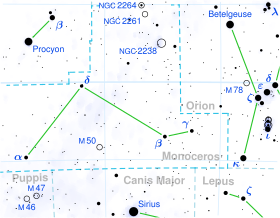18 Monocerotis is a binary star system located about half way from Orion's Belt to Procyon,[6] in the equatorial constellation of Monoceros.[11] It is visible to the naked eye as a faint, orange-hued star with an apparent visual magnitude of 4.47,[2] and is positioned around 370[1] light years away from the Sun based on parallax. The system is receding from the Earth with a heliocentric radial velocity of +11 km/s.[4]
| Observation data Epoch J2000 Equinox J2000 | |
|---|---|
| Constellation | Monoceros |
| Right ascension | 06h 47m 51.64752s[1] |
| Declination | 2° 24′ 43.7737″[1] |
| Apparent magnitude (V) | 4.47[2] |
| Characteristics | |
| Spectral type | K0+IIIaBa0.2[3] |
| U−B color index | +1.04[2] |
| B−V color index | +1.11[2] |
| Astrometry | |
| Radial velocity (Rv) | +11.29[4] km/s |
| Proper motion (μ) | RA: -16.898[1] mas/yr Dec.: -16.229[1] mas/yr |
| Parallax (π) | 8.0947 ± 0.2385 mas[1] |
| Distance | 400 ± 10 ly (124 ± 4 pc) |
| Absolute magnitude (MV) | -0.78[5] |
| Orbit[6][7] | |
| Primary | 18 Monocerotis A |
| Companion | 18 Monocerotis B |
| Period (P) | 1760.9±1.9 d |
| Semi-major axis (a) | 6.63 mas |
| Eccentricity (e) | 0.40±0.04 |
| Inclination (i) | 96.25° |
| Longitude of the node (Ω) | 47.63° |
| Periastron epoch (T) | 2441942.5 |
| Argument of periastron (ω) (secondary) | 172±6° |
| Details | |
| 18 Mon A | |
| Radius | 26.95+1.56 −0.81[1] R☉ |
| Luminosity | 311.2±10.5[1] L☉ |
| Surface gravity (log g) | 2.59[8] cgs |
| Temperature | 4,750[9] K |
| Metallicity [Fe/H] | -0.03[5] dex |
| Rotational velocity (v sin i) | < 2.0[10] km/s |
| Other designations | |
| Database references | |
| SIMBAD | data |
It is reported as a single-lined spectroscopic binary with an orbital period of 1,760.9 days (4.8 years) and an eccentricity of 0.4.[6] The visible component is an aging K-type giant star with a stellar classification of K0+IIIaBa0.2,[3] showing a slight overabundance of barium. The spectrum displays strong violet lines of CN.[6] With the supply of hydrogen at its core exhausted, this star has expanded to 27[1] times the radius of the Sun. It is radiating 311[1] times the luminosity of the Sun from its swollen photosphere at an effective temperature of 4,750 K.[9]
References edit
- ^ a b c d e f g h i j Brown, A. G. A.; et al. (Gaia collaboration) (August 2018). "Gaia Data Release 2: Summary of the contents and survey properties". Astronomy & Astrophysics. 616. A1. arXiv:1804.09365. Bibcode:2018A&A...616A...1G. doi:10.1051/0004-6361/201833051. Gaia DR2 record for this source at VizieR.
- ^ a b c d Ducati, J. R. (2002). "VizieR Online Data Catalog: Catalogue of Stellar Photometry in Johnson's 11-color system". CDS/ADC Collection of Electronic Catalogues. 2237. Bibcode:2002yCat.2237....0D.
- ^ a b Hoffleit, D.; Warren, W. H. (1995). "VizieR Online Data Catalog: Bright Star Catalogue, 5th Revised Ed. (Hoffleit+, 1991)". VizieR On-line Data Catalog: V/50. Originally Published in: 1964BS....C......0H. 5050. Bibcode:1995yCat.5050....0H.
- ^ a b Famaey, B.; Jorissen, A.; Luri, X.; Mayor, M.; Udry, S.; Dejonghe, H.; Turon, C. (2005). "Local kinematics of K and M giants from CORAVEL/Hipparcos/Tycho-2 data". Astronomy & Astrophysics. 430: 165–186. arXiv:astro-ph/0409579. Bibcode:2005A&A...430..165F. doi:10.1051/0004-6361:20041272. S2CID 17804304.
- ^ a b Anderson, E.; Francis, Ch. (2012). "XHIP: An extended hipparcos compilation". Astronomy Letters. 38 (5): 331. arXiv:1108.4971. Bibcode:2012AstL...38..331A. doi:10.1134/S1063773712050015. S2CID 119257644. Vizier catalog entry
- ^ a b c d Griffin, R. F. (1984). "Spectroscopic binary orbits from photoelectric radial velocities. Paper 59: 18 Monocerotis". The Observatory. 104: 267. Bibcode:1984Obs...104..267G.
- ^ ESA (1997). "The Hipparcos and Tycho Catalogues". VizieR On-line Data Catalog. Bibcode:1997yCat.1239....0E.
- ^ Soubiran, Caroline; Le Campion, Jean-François; Brouillet, Nathalie; Chemin, Laurent (2016). "The PASTEL catalogue: 2016 version". Astronomy & Astrophysics. 591: A118. arXiv:1605.07384. Bibcode:2016A&A...591A.118S. doi:10.1051/0004-6361/201628497. S2CID 119258214.
- ^ a b Gontcharov, G. A. (2009). "Red giant clump in the Tycho-2 catalogue". Astronomy Letters. 34 (11): 785–796. arXiv:1607.00619. Bibcode:2008AstL...34..785G. doi:10.1134/S1063773708110078. S2CID 73524157. Vizier catalog entry
- ^ De Medeiros, J. R.; Mayor, M. (1999). "A catalog of rotational and radial velocities for evolved stars". Astronomy and Astrophysics Supplement Series. 139 (3): 433. arXiv:astro-ph/0608248. Bibcode:1999A&AS..139..433D. doi:10.1051/aas:1999401. Vizier catalog entry
- ^ a b "18 Mon". SIMBAD. Centre de données astronomiques de Strasbourg. Retrieved 2019-05-30.
